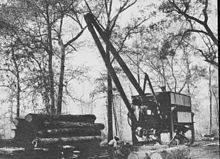Our website is made possible by displaying online advertisements to our visitors.
Please consider supporting us by disabling your ad blocker.
Logging



Logging is the process of cutting, processing, and moving trees to a location for transport. It may include skidding, on-site processing, and loading of trees or logs onto trucks[1] or skeleton cars. In forestry, the term logging is sometimes used narrowly to describe the logistics of moving wood from the stump to somewhere outside the forest, usually a sawmill or a lumber yard. In common usage, however, the term may cover a range of forestry or silviculture activities.
Logging is the beginning of a supply chain that provides raw material for many products societies worldwide use for housing, construction, energy, and consumer paper products. Logging systems are also used to manage forests, reduce the risk of wildfires, and restore ecosystem functions,[2] though their efficiency for these purposes has been challenged.[3]
Logging frequently has negative impacts. The harvesting procedure itself may be illegal, including the use of corrupt means to gain access to forests; extraction without permission or from a protected area; the cutting of protected species; or the extraction of timber in excess of agreed limits.[4] It may involve the so-called "timber mafia".[5][6] Excess logging can lead to irreparable harm to ecosystems, such as deforestation and biodiversity loss.[7][8] Infrastructure for logging can also lead to other environmental degradation. These negative environmental impacts can lead to environmental conflict.[7][8] Additionally, there is significant occupational injury risk involved in logging.
Logging can take many formats. Clearcutting (or "block cutting") is not necessarily considered a type of logging but a harvesting or silviculture method. Cutting trees with the highest value and leaving those with lower value, often diseased or malformed trees, is referred to as high grading. It is sometimes called selective logging, and confused with selection cutting, the practice of managing stands by harvesting a proportion of trees.[9] Logging usually refers to above-ground forestry logging. Submerged forests exist on land that has been flooded by damming to create reservoirs. Harvesting trees from forests submerged by flooding or dam creation is called underwater logging, a form of timber recovery.[10]
- ^ Society of American Foresters, 1998. Dictionary of Forestry. Archived 2011-07-25 at the Wayback Machine
- ^ Keifer, Matthew; Casanova, Vanessa; Garland, John; Smidt, Mathew; Struttmann, Tim (2019-04-03). "Foreword by the Editor-in-Chief and Guest Editors". Journal of Agromedicine. 24 (2): 119–120. doi:10.1080/1059924X.2019.1596697. ISSN 1059-924X. PMID 30890041. S2CID 150081506.
- ^ 'Logging emits three times as much carbon dioxide into the atmosphere per acre as wildfire alone. Most of the tree parts unusable for lumber – the branches, tops, bark and sawdust from milling – are burned for energy, sending large amounts of carbon into the atmosphere. In contrast, wildfire releases a surprisingly small amount of the carbon in trees, less than 2 percent. Logging in U.S. forests is now responsible for as much annual greenhouse gas emissions as burning coal.' Chad Hanson, Michael Dorsey, 'The Case Against Commercial Logging in Wildfire-Prone Forests,' New York Times 30 July 2022.
- ^ Illegal Logging.Info
- ^ Virginia Tech: Dealing with Timber Theft Archived 2008-10-17 at the Wayback Machine
- ^ msnbc.com – Guilty pleas in cedar tree theft September 23, 2008 [dead link]
- ^ a b Putz, Francis E.; Dykstra, Dennis P.; Heinrich, Rudolf (2000). "Why Poor Logging Practices Persist in the Tropics". Conservation Biology. 14 (4): 951–956. Bibcode:2000ConBi..14..951P. doi:10.1046/j.1523-1739.2000.99137.x. ISSN 0888-8892. JSTOR 2641994. S2CID 40156577.
- ^ a b "Environmental hazards from logging". The Encyclopedia of World Probems & Human Potential. 2020-10-04.
- ^ Forest Matters: Just Say No to High Grading page 8 Archived September 26, 2007, at the Wayback Machine
- ^ "Triton Logging". Archived from the original on 2011-02-08. Retrieved 2011-04-25.
Previous Page Next Page


